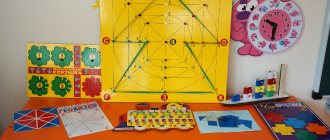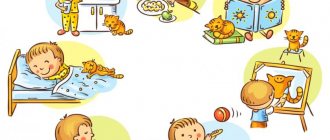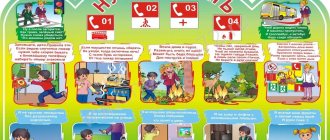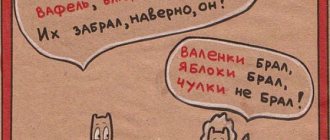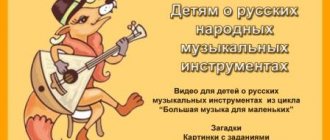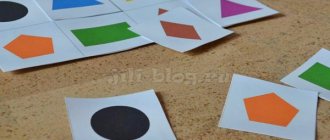Insert pictures
The insert picture is a picture with parts cut out. You need to find the missing pieces and put them in their places to create a complete image. For example, a drawing of a fruit bowl in which individual fruits are cut out. This game is intended for children from 2 to 4 years old. Its task can be expressed by the question “what is missing here?” Usually, children as young as two years old can easily cope with inserts, for example, with a row of vegetables and fruits or a row of dogs of the same shape, but of different sizes.
Thus, classes with insert pictures are very good for the formation and development of visual-figurative thinking that is just emerging in the baby.
It is necessary to choose insert pictures based on the age of the child: the younger he is, the fewer pieces should be cut out, and the larger the details.
In the simplest version of this game, the cut out fragment has smooth edges, and the design depicted on it is symmetrical (for example, a symmetrical daisy on a square piece). Or the shape of the piece matches the image: a cut out cup, saucer, spoon, etc. In these cases, in order to cope with the task, the child simply needs to understand which part of the picture this element is from. To complicate the task, you can offer your child a picture with uneven edges of the cutouts that do not coincide with the boundaries of the picture.
It is even more difficult for a child to cope with a picture, the cut-out parts of which have smooth edges, but the image located on them is asymmetrical: for example, a bird is drawn on a square - the child has to be careful not to put it upside down. Or each piece does not represent a separate image, but only a part of it, for example, a fragment of a vase or flower. Here the child is forced to focus on the shape of the cutout and the corresponding piece (we insert a circle into a round cutout, a triangle into a triangular cutout), and also take into account the content of what is drawn, correlate the details of the image, all the lines, colors and location of the drawing. These insert pictures are especially difficult for a child due to age characteristics, and at some stage he will need the help of an adult. However, such games prepare the basis for the successful development of visual and figurative thinking. The experience gained will allow the child to more easily cope with much more complex puzzles.
How to use printable assignments
How to work with picture puzzles for children:
- print out the proposed puzzle picture, prepare scissors, and, if desired, a clean sheet of paper and glue;
- Explain the task to the child. That's it, the part for adults is over;
- then completely independent work : cut the puzzle along the contours;
- reassemble the puzzle in the correct order;
- stick on a blank sheet of paper as a finished applique.
Please note that some pictures specifically do not contain lines and patterns flowing from one puzzle element to another. This kind of puzzle is more difficult to assemble; you need to rely only on the shape of the elements, and to do this you need to cut the picture very carefully.
Cutting pictures
A cut picture is a picture cut along straight (usually) lines. The child does not have to think about the shape of the pieces and can focus on the image. This activity is good for children from 2 to 5 years old. The fact is that until a child is 5 years old, it is quite difficult for him to navigate according to two parameters at once - the shape of the pieces (the way the picture is cut) and the content (what is depicted). However, it is at this age that cut-out pictures most contribute to the development of visual-figurative thinking.
The simplest cut pictures are images of individual objects familiar to the child (bucket, house, butterfly), cut into two symmetrical parts. The difficulty of assembling the picture increases with the number of parts and with the appearance of the plot. Games with cut-out pictures bring great pleasure to kids. For example, a house divided into parts (“roof”, “wall”, “base”) can be “built”. Thanks to this game, the child develops concentration, observation, imagination, visual perception and develops holistic ideas about the subject.
When buying or making cut-out pictures yourself, you need to pay attention to the following points: the image in the picture must be recognizable (in this regard, for a European child, a bear is better than a rhinoceros, and a rhinoceros is better than a cuttlefish); the colors used in the drawing should be bright, but not irritating; the number of parts must be age appropriate.
Pictures for the puzzle to print
To make a regular puzzle for children with your own hands, just take any picture and cut it into any number of pieces. But with shaped puzzles everything is more complicated.
Cubes
Composite pictures on cubes have their own peculiarity associated with the shape of the cube. A fragment located on each face is no longer just part of a flat image. To get the picture, it is not enough to put the cube in its place, it needs to be turned the right way. Composite pictures on the cubes suggest the presence of a basic understanding of the cube. This type of composite pictures fulfills its developmental task for children from 3-4 to 6-7 years old. You need to start your acquaintance with four cubes, on which there is an image of a separate object (fruit, dog, car, etc.). When offering a game, all the cubes need to be turned with one picture facing up - this simplifies the task, the baby just needs to place them in the correct order. As the child masters this game, the task needs to be complicated: first, turn one cube the wrong way and ask the child to find the missing part of the picture on it, then do the same with two cubes, with three. Gradually the child will get used to this game.
Now he can be offered a plot image in pictures (for example, a scene from a familiar fairy tale).
What are the benefits of cubes? Many of them are made in the same style, for example, on all sides there are scenes from fairy tales, and on three sides events taking place in the hut are depicted, and on the other three - in the forest; all sides are painted in the same color scheme. Therefore, sometimes it is not easy even for an adult to determine at first glance whether the cube is turned the right way. To avoid mistakes, you need to be very careful and patient.
Important points when choosing cubes: unity of style, color scheme, similarity of plot and age-appropriate level of difficulty. It is precisely these cubes that will most effectively fulfill their developmental task.
Drawn pictures
For the formation of a passive vocabulary, pictures for children depicting various toys are of great importance. It is very good if they are presented in a wide variety, this allows you to offer the child many different speech exercises and activities.
For speech therapy games, it is much more convenient to use cards rather than real objects. Sorting and describing images not only contributes to children’s speech development, but also improves them:
- visual-figurative thinking;
- RAM;
- attention.
Of course, it is very difficult to draw such pictures yourself; it is better to find ready-made ones selected by professional speech therapists.
Games
With “Toys” pictures you can conduct many simple and effective speech therapy activities aimed at developing the speech of preschool children. Here are some examples of such games:
Name the pictures
The development of children's speech is facilitated by naming the various toys depicted on the cards. It is important to choose the most realistic drawings, this helps the child quickly recognize this or that object. Such pictures of toys for children must certainly be bright and attractive in appearance.
What's missing here?
The popular logic game “Odd Four” can also be used in speech therapy classes. During it, children are offered four images, three of which can be called in one word (“toys”), and one cannot; this card is selected from other categories (vegetables, plants, animals, transport, etc.). This game helps to enrich and activate passive vocabulary, and also perfectly trains the attention and thinking of preschoolers.
Which? Which? Which?
Show your child one picture at a time from the set of “Toys” cards and ask him to list the properties of the object depicted on it. For example: a doll - new, elegant, plastic, curly, blue-eyed, big, new, etc. If you have pictures from the Toys for Children series on a transparent background, then it is better to use them in this game.
Call me kindly
This game is great for developing the skill of using diminutive suffixes on nouns. An adult shows children 4 years and older toys (in pictures or real ones) and asks them to name them affectionately. Examples:
- doll - doll; - ball - ball; - bear - bear; - elephant - elephant; - hare - bunny; - car - machine; - jump rope - jump rope.
For children of senior preschool age 6-7 years old, you can conduct a complicated lesson: ask them to remember the names of toys that are used only in an “affectionate” form. (top, pyramid) or do not have it at all (spinning top, hoop, train, clown, etc.).
One-many
Teach your child not only to name toys one by one, but also to find one or another of them in a group of similar/identical images. Example:
ball - ball doll - dolls cube - cubes ball - balls.
Detectives
Another simple and exciting game that will help your child quickly learn the names of a large number of toys. As visual material for it you can use:
- Pictures;
- real objects for games;
- video materials.
First you need to show four different pictures with images of toys, and then hide (close) one of the cards. The baby must remember and name what is missing.
Guess what color
Invite your child to name the color of the toy you show him. You need to start with basic colors, then you can add more complex options, with shades (bright red, scarlet, dark green, light pink). During this game you can also reinforce the concepts
- bright; – multi-colored; - transparent; – multi-color.
Whose toy is this?
This exercise allows you to teach a preschool child how to coordinate nouns (names of toys) with personal pronouns. You show your child a picture and ask: “Whose is this?” Possible answers:
my (dog, spinning top, pyramid) my (ball, elephant, bunny, clown) my (lotto, dominoes) my (cubes, balls)
Who's doing what?
This game allows you to train the skill of agreeing a noun with a verb. Show your child pictures of toys (singular and plural, pairs) one at a time and ask the question: “What is this? What is he doing? Possible answers:
the doll is sleeping - the dolls are sleeping the parsley is sitting - the parsleys are sitting the bunny fell from the shelf - the bunnies fell from the shelf the top is spinning - the tops are spinning the ball rolled away - the balls rolled away the car broke down - the cars broke down the bear is sleeping - the bears are sleeping
The large picture “Toys for Children” can be used for a similar activity with several kids at once, in a group or subgroup.
What toy?
This fun game helps children learn the rules of noun-adjective agreement quickly and easily. Ask your child to come up with as many characteristics as possible for the toy whose image is in your hands. It is best to play this game among several children or in an adult-child pair. Try to avoid repeating adjectives; it is important to name as many different words as possible.
Example:
The horse is wooden, new, beloved, comfortable, hard, smooth, brown. Elephant - purple, soft, big, sad, big-eared.
Shop
The usual game of “shopping” can be slightly modified and effectively used to develop the speech of children in the senior and preparatory groups of kindergarten. Invite the children to choose a card from the “Toys” set, i.e., “make a purchase.” Then the boy or girl goes to the window and chooses a “purchase”. The child must accompany his actions with a correctly constructed complete sentence, in which he must name the selected object and several of its characteristics (color, material, size and other features). This exercise helps enrich children's active vocabulary and develop their imagination.
Example:
1. I want to buy a big yellow ball. 2. I want to buy a bright red cube. 3. I want to buy an elegant little doll. 4. I want to buy a set of wooden blocks in a box.
The picture Toys for Children on a transparent background is very suitable for this game, although ordinary cardboard cards can also be used.
Coloring pages
To conduct classes on the topic “Toys” it is also very useful to use thematic coloring books. They help the child not only learn and remember all kinds of names of objects for games, but also practice using a large number of descriptive adjectives (in descriptions of various colors and materials). A correctly selected coloring book is a real helper for speech therapists and parents!
Methods of teaching children 2–3 years old with cut-out pictures and building materials
**Elena Vladimirovna Tochenova**
Methods of teaching children 2–3 years old with cut-out pictures and building materials
Cut-out pictures can be subject or subject. subject pictures independently, but plot pictures, which are more complex, are used only with a teacher, since the picture needs to be disassembled : what is drawn on it, then put this picture from separate parts together. Gradually, you can give your child whole and cut pictures for independent work. Instead of pictures , you can use cubes.
Playing with building materials is difficult for children , since it does not prompt the child to take action, so the teacher must interest the children in the game and lead them to story-based buildings . To do this, conducting special classes , constructing buildings , first the teacher, then what kind of children. You need to start with simple buildings , turrets, houses, then gates, tables, chairs, sofas, etc.
You need to build together with children , commenting on your actions, leading a 3-year-old child to meaningful play. For example: “Now we will build a house ”
, the teacher explains where the roof will be, where the door is, where the window is.
The child should not copy the sample exactly. We must strive to ensure that children understand what and how can be built from cubes . Gradually, children begin to play independently. The teacher is only interested in what they built ; if the child finds it difficult to answer, then the teacher tells him what happened.
If children turn to the teacher and name what they have done, he should give advice that would complicate its construction . For example: “Where will the house have a beautiful window, or “where will the bunny sit ”
, or
“will the bear have a balcony,”
etc.”
While playing with building materials, children are given the concepts of small and large, high and low, long and short, wide and narrow. They are also given the concepts of color: red, yellow, green cubes. All concepts are given one by one, and as they are mastered.
If the group is well equipped, then with the active influence of the teacher on the children, the child’s independent play will deepen and expand.
By the age of 3, a child consciously sets a goal for himself what he will do and independently selects material according to size , shape and color. It is important at this moment to ensure that the children finish what they start. If the teacher sees that the child is not succeeding and the desire to build , he must help, suggest or direct what else can be done to achieve the final intended result.
And one more important circumstance is that you need to ensure that building is not accidentally destroyed by children or adults .
